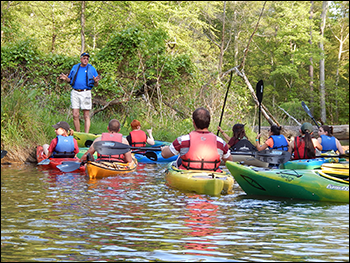|
The Bay as Teaching Tool

Photograph by Michael Allen
SCIENCE TEACHERS IN MARYLAND are facing several problems. And the Chesapeake Bay may offer some solutions. One problem: finding a better way of teaching science, whether in grade school, high school, or college. According to many education experts, the way most students learn science is outdated. It relies too much on memorizing facts and not enough on thinking like a scientist. In 2013 the Maryland State Board of Education adopted a new set of science education standards for the state's 24 school districts. They go by the name Next Generation Science Standards and they tell teachers to provide students some "inquiry-based" experiences in the classroom.
A second problem teachers face: raising environmental literacy levels. Since 2011 the state has told them to focus more on environmental issues in their science and social science classes.
Making big changes is easier said than done, but a number of Maryland teachers are already pioneering new approaches to these problems. They are giving students hands-on research projects that require them to investigate a question, absorb basic concepts, and follow the scientific method. And they are putting students to work on "inquiry projects" that examine aspects of the Chesapeake Bay ecosystem. The Bay, it turns out, offers workable options for drawing students into science, a field that seems daunting to many.
So daunting that most adults in the current generation of Americans have a poor grasp of basic facts about the environment. In 2010 the Yale Project on Climate Change Communication quizzed 2,000 Americans about their knowledge of climate change -- and the results were troubling. Fewer than one in 10 would earn an "A" or "B," and only one in four had even heard of coral bleaching or ocean acidification, two side effects of rising greenhouse gases.
Will the next generation do better? Perhaps, but only if teachers find better ways of drawing students into the challenges, rigor, and rewards of doing good science. In recent years, giving students a hands-on research experience is emerging as one of the key tools in science education. To work well, however, a hands-on project needs a question, a question interesting enough to stir students' interests and energies and commitment to finding an answer. The Bay, with its seagrasses and striped bass, its crabs and oysters, and its far-reaching watershed, poses plenty of interesting questions.
In this issue, Bringing the Bay into the Classroom examines the progress and pitfalls of bringing marine science into the science curricula of our state schools. Science education, of course, doesn't end with high school. For college students ready to plunge deeper into marine science, Maryland Sea Grant offers select undergraduates the chance to spend a summer at a working marine laboratory on the Chesapeake Bay. Living the Life of a Marine Scientist explores how students respond to submerging themselves in a summer-long science inquiry project
Programs like these are important not just for training scientists, but for educating citizens. Students who study the Bay learn to understand environmental issues such as declining fisheries and deteriorating water quality. And marine education becomes a critical step in creating a next generation of Marylanders who could make decisions in their day-to-day lives to help preserve an ecosystem they've learned to understand.
— The Editors
|